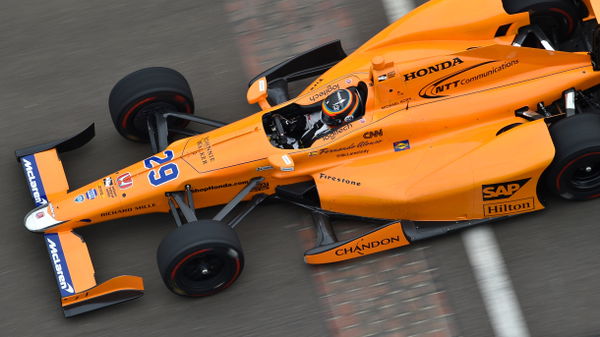

Instead of suiting up for F1’s most prestigious race – the Monaco Grand Prix – on May 28, Alonso will instead contest the Indianapolis 500 with Honda-engined IndyCar team Andretti Autosport. This has McLaren’s full blessing. In fact, McLaren’s new executive director Zak Brown helped negotiate the deal, and the car will run as a McLaren entry in an orange livery.
“Everybody has got his own tricks when you have to negotiate a contract,” said McLaren

ADVERTISEMENT
Article continues below this ad
But what if the ‘tricks’ Boullier speaks of don’t work, and inadvertently hand Alonso the sort of power that could potentially open a Pandora’s box of negative consequences for McLaren-Honda further down the road?
The original three-year agreement Alonso signed to join McLaren-Honda after leaving Ferrari at the end of 2014 expires at the end of this year. According to Brown, there is also an agreement between McLaren and Alonso that his F1 future will not be discussed until the summer, and that Alonso will not commit to a rival until then too.
Alonso said during McLaren’s pre-season launch that he would leave thoughts of next year until F1’s August break, but in the meantime, McLaren is doing everything in its power to try to ensure Alonso’s head is not turned by the promise of greener grass in pastures new – or old for that matter.
Approaching 2018, the driver market is more open than it has been for some time. Lewis Hamilton has a deal with Mercedes; both Red Bull drivers are locked in; Nico Hulkenberg has only just begun a multi-year partnership with Renault; Esteban Ocon, Kevin Magnussen and Stoffel Vandoorne are on similar terms at Force India, Haas and McLaren respectively. But otherwise pretty much all bets are off.
Meanwhile, McLaren remains in a dire competitive position, requiring a miraculous turnaround from Honda to have any chance of meeting this year’s target of competing with the top three teams in the championship. Alonso does not appear to have many realistic alternative options, but open seats at Mercedes, Ferrari and Renault will have everyone’s noses twitching.

There can be no doubt allowing Alonso to skip the Monaco Grand Prix to contest the Indy 500 is an extraordinary move. Monaco is the jewel in F1’s crown, not to mention potentially McLaren’s best chance of a decent result across the first third of the season, given the Honda engine’s obvious deficiencies.
Yes it is a great story for F1, a great way of deflecting attention (however briefly) from McLaren’s woeful start to 2017, and a great opportunity for Alonso to showcase his skills in an arena contemporary F1 drivers haven’t touched for decades.
Alonso could transcend Jacques Villeneuve and Juan Pablo Montoya; begin to approach the feats of Emerson Fittipaldi (two F1 titles and two Indy 500 wins); aspire to emulate Graham Hill if he can win Le Mans too, and potentially stun the American scene in the way Jim Clark did in 1965.

Clark also skipped Monaco to compete at Indy that year, but sadly Alonso has no hope of doing the Indy 500/F1 world championship double in 2017 that Clark managed in 1965.
But, as several drivers said, Formula 1 is a different and much more specialist animal these days, and Alonso could surely have waited until he’s finished with F1 to dabble in IndyCar.
It’s a sign of the power he now wields within McLaren that this team would go to such extraordinary lengths to keep him happy – to urge him to sign a new deal when his current one expires.
McLaren’s desire is understandable. Alonso is not a faded star trading on past glories, merely counting the races as he coasts gently towards retirement.
He remains one of F1’s fiercest competitors. He claims he is more prepared this year than ever before and is driving better than ever too. His performances in the first three races of 2017 support that impression, brutally exposing the weaknesses in the McLaren-Honda package.
Alonso is a premier operator, still at the top of his game at 35 years old. That buys him power.
“There is a history of him getting himself caught up in power struggles in the teams he’s been involved with, which may have rendered him a liability,” says 1996 world champion Damon Hill. He further adds:

“I think it’s been difficult for him to get a power base within a team. Michael Schumacher would have a power base – they would dedicate themselves to giving him what he wanted because they knew he would deliver. It hasn’t quite happened with Fernando. Some teams might have been concerned about the power he wields – certainly in terms of his ability to express a point of view which might not be flattering to the team, so in some senses he is maybe too hot to handle. I think that’s a mistake, because when Formula 1 is at its best it recognises the driver as an equal partner in the game with the teams, and certain drivers establish themselves as being as important as teams. When you have teams like McLaren or Ferrari, they have so much invested in their organisations that they find that very difficult to deal with. It’s a bit like the film Gladiator – when the performer within the arena becomes more powerful than the Emperor. I wouldn’t say he’s as volatile as Senna, but certainly Senna was as difficult to handle for teams as Alonso is. But it’s because he knows how good he is, and how much he’s got to give.”
Hill is positive about McLaren supporting and facilitating Alonso’s Indy 500 quest, describing it as a “PR coup”. It is perhaps a sign that the ‘new’ McLaren recognises the need to be less domineering over its drivers, regardless of any ulterior motive.
“It shows that it respects the driver’s career,” Hill adds. “The teams can’t change – they are always going to be the teams for forever and a day, until they go bust or whatever. But a driver has ambitions that he wants to fulfil, and if he can’t do that then he will go somewhere where he can feel fulfilled as a racing driver. I think it’s wrong if F1 restricts that. It was a

Alonso has arguably become increasingly valuable to McLaren during these past three seasons, precisely because performance and results have fallen so woefully short of expectation.
Retaining a driver of Alonso’s calibre is perhaps key to McLaren’s self-perception. Right now it’s stuck in a phase that swallows up the big teams that underperform in F1 for too long, and spits them out as something less than they once were.
Keeping Alonso could play a big part in ensuring the whole house of cards avoids caving in on itself. But the price of such reinforcement seems to be granting Alonso more influence, or at the very least acknowledging the power he already holds – to do what he wants, to call the shots, to potentially mould the team around his own interests.
Arguably this is an organic process that happens regardless when you employ a driver of such obvious elite ability. What group of talented designers, engineers and mechanics would not be enthused by having the best possible human reference point against which to validate the countless hours they have spent toiling to produce the best racing car they possibly can?
“It’s very rare he makes a mistake,” says Boullier of Alonso. “I’ve never seen this in my life before – he can extract 100% out of the car on the first lap. On the first run, already you know you can use the data to work on because you know he was on the limit of the car. Once you know him, it’s just respect and you save time. The level of trust people have with him is just unbelievable. Every time he goes out, you know this is the best we can do. The whole organisation trusts him as a reference point.”

But Alonso is not a computer, even if he is considered by some within Formula 1 as the closest human equivalent in driving terms. He has needs and wants and desires, and like most people in most walks of life, he needs to be happy to perform at his best.
McLaren clearly wants to do whatever it can to ensure this potential ‘winning combination’ stays together, but what happens if the Indy 500 is just the thin end of the wedge? What if Alonso starts wielding more power, and making greater demands of the team for it to secure his loyalty? At what point will McLaren have to do what it hasn’t done in this instance and say no?
ADVERTISEMENT
Article continues below this ad
And what if Alonso reaches the August break with no clear indication that McLaren and Honda are going to finally deliver on the promises that tempted him to return in the first place? If Alonso decides to leave regardless, how will McLaren recover the power it has so readily handed over when Alonso’s replacement comes along?
Formula 1 world champions will always control their own destinies to a greater extent than other drivers, but teams are not often beholden to their whims. By bending over backwards for Alonso, McLaren has ensured he holds its immediate future in the palm of his hand.
That is a risky game to play, because what Alonso decides to do next could decide the destiny of McLaren-Honda.
ADVERTISEMENT
Article continues below this ad

ADVERTISEMENT
ADVERTISEMENT
ADVERTISEMENT
ADVERTISEMENT

